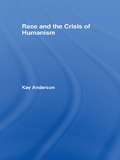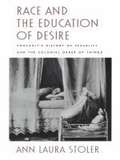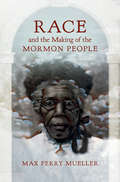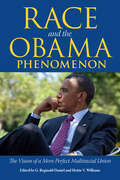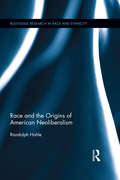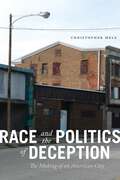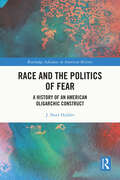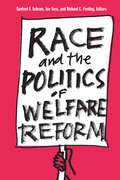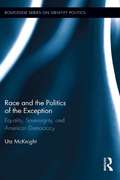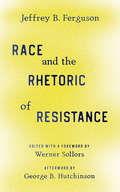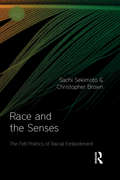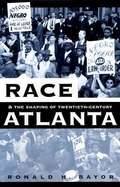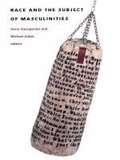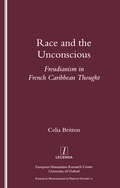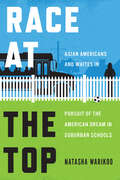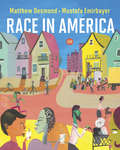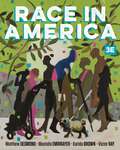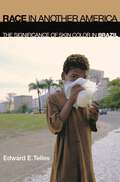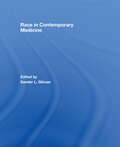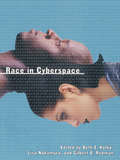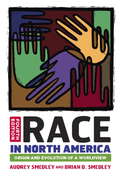- Table View
- List View
Race and the Crisis of Humanism
by Kay AndersonThe idea that humankind constituted a unity, albeit at different stages of 'development', was in the 19th century challenged with a new way of thinking. The 'savagery' of certain races was no longer regarded as a stage in their progress towards 'civilisation', but as their permanent state. What caused this shift? In Kay Anderson's provocative new account, she argues that British colonial encounters in Australia from the late 1700s with the apparently unimproved condition of the Australian Aborigine, viewed against an understanding of 'humanity' of the time (that is, as characterised by separation from nature), precipitated a crisis in existing ideas of what it meant to be human. This lucid, intelligent and persuasive argument will be necessary reading for all scholars and upper-level students interested in the history and theories of 'race', critical human geography, anthropology, and Australian and environmental studies.
Race and the Education of Desire: Foucault’s History of Sexuality and the Colonial Order of Things
by Ann Laura StolerMichel Foucault's History of Sexuality has been one of the most influential books of the last two decades. It has had an enormous impact on cultural studies and work across many disciplines on gender, sexuality, and the body. Bringing a new set of questions to this key work, Ann Laura Stoler examines volume one of History of Sexuality in an unexplored light. She asks why there has been such a muted engagement with this work among students of colonialism for whom issues of sexuality and power are so essential. Why is the colonial context absent from Foucault's history of a European sexual discourse that for him defined the bourgeois self? In Race and the Education of Desire, Stoler challenges Foucault's tunnel vision of the West and his marginalization of empire. She also argues that this first volume of History of Sexuality contains a suggestive if not studied treatment of race.Drawing on Foucault's little-known 1976 College de France lectures, Stoler addresses his treatment of the relationship between biopower, bourgeois sexuality, and what he identified as "racisms of the state." In this critical and historically grounded analysis based on cultural theory and her own extensive research in Dutch and French colonial archives, Stoler suggests how Foucault's insights have in the past constrained--and in the future may help shape--the ways we trace the genealogies of race.Race and the Education of Desire will revise current notions of the connections between European and colonial historiography and between the European bourgeois order and the colonial treatment of sexuality. Arguing that a history of European nineteenth-century sexuality must also be a history of race, it will change the way we think about Foucault.
Race and the Making of the Mormon People
by Max Perry MuellerThe nineteenth-century history of the Church of Jesus Christ of Latter-day Saints, Max Perry Mueller argues, illuminates the role that religion played in forming the notion of three "original" American races—red, black, and white—for Mormons and others in the early American Republic. Recovering the voices of a handful of black and Native American Mormons who resolutely wrote themselves into the Mormon archive, Mueller threads together historical experience and Mormon scriptural interpretations. He finds that the Book of Mormon is key to understanding how early followers reflected but also departed from antebellum conceptions of race as biblically and biologically predetermined. Mormon theology and policy both challenged and reaffirmed the essentialist nature of the racialized American experience. The Book of Mormon presented its believers with a radical worldview, proclaiming that all schisms within the human family were anathematic to God's design. That said, church founders were not racial egalitarians. They promoted whiteness as an aspirational racial identity that nonwhites could achieve through conversion to Mormonism. Mueller also shows how, on a broader level, scripture and history may become mutually constituted. For the Mormons, that process shaped a religious movement in perpetual tension between its racialist and universalist impulses during an era before the concept of race was secularized.
Race and the Obama Phenomenon: The Vision of a More Perfect Multiracial Union
by G. Reginald Daniel and Hettie V. WilliamsThe concept of a more perfect union remains a constant theme in the political rhetoric of Barack Obama. From his now historic race speech to his second victory speech delivered on November 7, 2012, that striving is evident. “Tonight, more than two hundred years after a former colony won the right to determine its own destiny, the task of perfecting our union moves forward,” stated the forty-fourth president of the United States upon securing a second term in office after a hard-fought political contest. Obama borrows this rhetoric from the founding documents of the United States set forth in the US Constitution and in Abraham Lincoln's “Gettysburg Address.” How naive or realistic is Obama's vision of a more perfect American union that brings together people across racial, class, and political lines? How can this vision of a more inclusive America be realized in a society that remains racist at its core? These essays seek answers to these complicated questions by examining the 2008 and 2012 elections as well as the events of President Obama's first term. Written by preeminent race scholars from multiple disciplines, the volume brings together competing perspectives on race, gender, and the historic significance of Obama's election and reelection. The president heralded in his November 2012, acceptance speech, “The idea that if you're willing to work hard, it doesn't matter who you are, or where you come from, or what you look like . . . . whether you're black or white, Hispanic or Asian or Native American.” These essayists argue the truth of that statement and assess whether America has made any progress toward that vision.
Race and the Origins of American Neoliberalism (Routledge Research in Race and Ethnicity #12)
by Randolph HohleWhy did the United States forsake its support for public works projects, public schools, public spaces, and high corporate taxes for the neoliberal project that uses the state to benefit businesses at the expense of citizens? The short answer to this question is race. This book argues that the white response to the black civil rights movement in the 1950s, '60s, and early '70s inadvertently created the conditions for emergence of American neoliberalism. Neoliberalism is the result of an unlikely alliance of an elite liberal business class and local segregationists that sought to preserve white privilege in the civil rights era. The white response drew from a language of neoliberalism, as they turned inward to redefine what it meant to be a good white citizen. The language of neoliberalism depoliticized class tensions by getting whites to identify as white first, and as part of a social class second. This book explores the four pillars of neoliberal policy, austerity, privatization, deregulation, and tax cuts, and explains how race created the pretext for the activation of neoliberal policy. Neoliberalism is not about free markets. It is about controlling the state to protect elite white economic privileges.
Race and the Politics of Deception: The Making of an American City
by Christopher MeleWhat is the relationship between race and space, and how do racial politics inform the organization and development of urban locales?In Race and the Politics of Deception, Christopher Mele unpacks America’s history of dealing with racial problems through the inequitable use of public space. Mele focuses on Chester, Pennsylvania—a small city comprised of primarily low-income, black residents, roughly twenty miles south of Philadelphia. Like many cities throughout the United States, Chester is experiencing post-industrial decline. A development plan touted as a way to “save” the city, proposes to turn one section into a desirable waterfront destination, while leaving the rest of the struggling residents in fractured communities. Dividing the city into spaces of tourism and consumption versus the everyday spaces of low-income residents, Mele argues, segregates the community by creating a racialized divide. While these development plans are described as socially inclusive and economically revitalizing, Mele asserts that political leaders and real estate developers intentionally exclude certain types of people—most often, low-income people of color.Race and the Politics of Deception provides a revealing look at how our ever-changing landscape is being strategically divided along lines of class and race.
Race and the Politics of Fear: A History of an American Oligarchic Construct (Routledge Advances in American History)
by J. Noel HublerRace and the Politics of Fear is a study of the role of race in American political history. It takes a novel approach by using Aristotle’s theory of the mixed regime to analyze the American system. Aristotle’s mixed regime - containing elements of oligarchy and democracy - was well-known to the Founders, who used it to design the Constitution. Accordingly, American political history has unfolded as a struggle between oligarchic and democratic forces. Oligarchs have frequently used race to divide the people and maintain power.This book traces the oligarchic construction of race from its creation in the Colonial period and through a study of four major figures. James Madison helped formulate the Constitution to provide protection for the Southern oligarchies and was a founder of the Democratic-Republican party dominated by Southern interests. John C. Calhoun’s theory of the concurrent majority provided a blueprint for the South’s political strategy in the Jim Crow era. Ben Tillman redefined race primarily as a feeling as an excuse for the South’s violent oppression of the black community. Ronald Reagan retooled the traditional racist myths and made them palatable to a national audience.Readable yet extensively documented, it is appropriate for general audiences and scholars.
Race and the Politics of Welfare Reform
by Sanford Schram Joe Soss Richard C. FordingIt's hard to imagine discussing welfare policy without discussing race, yet all too often this uncomfortable factor is avoided or simply ignored. Sometimes the relationship between welfare and race is treated as so self-evident as to need no further attention; equally often, race in the context of welfare is glossed over, lest it raise hard questions about racism in American society as a whole. Either way, ducking the issue misrepresents the facts and misleads the public and policy-makers alike. Many scholars have addressed specific aspects of this subject, but until now there has been no single integrated overview. Race and the Politics of Welfare Reform is designed to fill this need and provide a forum for a range of voices and perspectives that reaffirm the key role race has played--and continues to play--in our approach to poverty. The essays collected here offer a systematic, step-by-step approach to the issue. Part 1 traces the evolution of welfare from the 1930s to the sweeping Clinton-era reforms, providing a historical context within which to consider today's attitudes and strategies. Part 2 looks at media representation and public perception, observing, for instance, that although blacks accounted for only about one-third of America's poor from 1967 to 1992, they featured in nearly two-thirds of news stories on poverty, a bias inevitably reflected in public attitudes. Part 3 discusses public discourse, asking questions like "Whose voices get heard and why?" and "What does 'race' mean to different constituencies?" For although "old-fashioned" racism has been replaced by euphemism, many of the same underlying prejudices still drive welfare debates--and indeed are all the more pernicious for being unspoken. Part 4 examines policy choices and implementation, showing how even the best-intentioned reform often simply displaces institutional inequities to the individual level--bias exercised case by case but no less discriminatory in effect. Part 5 explores the effects of welfare reform and the implications of transferring policy-making to the states, where local politics and increasing use of referendum balloting introduce new, often unpredictable concerns. Finally, Frances Fox Piven's concluding commentary, "Why Welfare Is Racist," offers a provocative response to the views expressed in the pages that have gone before--intended not as a "last word" but rather as the opening argument in an ongoing, necessary, and newly envisioned national debate.
Race and the Politics of the Exception: Equality, Sovereignty, and American Democracy (Routledge Series on Identity Politics)
by Utz McKnightThe traditional assumption today about race is that it is not political; that it has no political content and is a matter of individual beliefs and attitudes. In Race and the Politics of the Exception, Utz McKnight argues that race is in fact political and defines how it functions as a politics in the United States. McKnight organizes his book into three sections, beginning with a theoretical section about racial politics in the United States. Using theorists such as Benjamin, Agamben, and Schmitt, McKnight discusses how the idea of racial communities went from being constituted through the idea of racial sovereignty and a politics of the exception that defined blacks as the internal enemy, to being constitutionally defined through the institutions of racial equal opportunity. In the second section, McKnight further develops his critical race theory by exploring in more detail the social use of race today. The election of President Obama has brought the politics of racial equality to a critical point. In spite of a very powerful set of political tools to define it as a thing of the past, race matters. In the final section, McKnight engages with important African American fiction from each of the three major periods of racial politics in the US. Earlier descriptions of political theory are used throughout these analyses to refine the argument for a new critical politics of race. Scholars of political theory, identity politics, African American studies, and American Studies will find this work ground-breaking and relevant.
Race and the Rhetoric of Resistance
by Jeffrey B. FergusonContinuing in the vein of his ever questioning the conventions of race melodrama through the lens of which so much American racial and cultural history and storytelling has been filtered, Ferguson's final work conveys to the reader his sense of humor, warmth, and grace, while adding up to a serious, principled critique of much common scholarly and pedagogic practice..
Race and the Senses: The Felt Politics of Racial Embodiment (Sensory Studies)
by Christopher Brown Sachi SekimotoIn Race and the Senses, Sachi Sekimoto and Christopher Brown explore the sensorial and phenomenological materiality of race as it is felt and sensed by the racialized subjects. Situating the lived body as an active, affective, and sensing participant in racialized realities, they argue that race is not simply marked on our bodies, but rather felt and registered through our senses. They illuminate the sensorial landscape of racialized world by combining the scholarship in sensory studies, phenomenology, and intercultural communication. Each chapter elaborates on the felt bodily sensations of race, racism, and racialization that illuminate how somatic labor plays a significant role in the construction of racialized relations of sensing. Their thought-provoking theorizing about the relationship between race and the senses include race as a sensory assemblage, the phenomenology of the racialized face and tongue, kinesthetic feelings of blackness, as well as the possibility of cross-racial empathy. Race is not merely socially constructed, but multisensorially assembled, engaged, and experienced. Grounded in the authors’ experiences, one as a Japanese woman living in the USA, and the other as an African American man from Chicago, Race and the Senses is a book about how we feel the racialized world into being.
Race and the Shaping of Twentieth-Century Atlanta
by Ronald H. BayorAtlanta is often cited as a prime example of a progressive New South metropolis in which blacks and whites have forged "a city too busy to hate." But Ronald Bayor argues that the city continues to bear the indelible mark of racial bias. Offering the first comprehensive history of Atlanta race relations, he discusses the impact of race on the physical and institutional development of the city from the end of the Civil War through the mayorship of Andrew Young in the 1980s. Bayor shows the extent of inequality, investigates the gap between rhetoric and reality, and presents a fresh analysis of the legacy of segregation and race relations for the American urban environment. Bayor explores frequently ignored public policy issues through the lens of race--including hospital care, highway placement and development, police and fire services, schools, and park use, as well as housing patterns and employment. He finds that racial concerns profoundly shaped Atlanta, as they did other American cities. Drawing on oral interviews and written records, Bayor traces how Atlanta's black leaders and their community have responded to the impact of race on local urban development. By bringing long-term urban development into a discussion of race, Bayor provides an element missing in usual analyses of cities and race relations.
Race and the Subject of Masculinities
by Harilaos Stecopoulos Michael UebelAlthough in recent years scholars have explored the cultural construction of masculinity, they have largely ignored the ways in which masculinity intersects with other categories of identity, particularly those of race and ethnicity. The essays in Race and the Subject of Masculinities address this concern and focus on the social construction of masculinity--black, white, ethnic, gay, and straight--in terms of the often complex and dynamic relationships among these inseparable categories.Discussing a wide range of subjects including the inherent homoeroticism of martial-arts cinema, the relationship between working-class ideologies and Elvis impersonators, the emergence of a gay, black masculine aesthetic in the works of James Van der Zee and Robert Mapplethorpe, and the comedy of Richard Pryor, Race and the Subject of Masculinities provides a variety of opportunities for thinking about how race, sexuality, and "manhood" are reinforced and reconstituted in today's society. Editors Harry Stecopoulos and Michael Uebel have gathered together essays that make clear how the formation of masculine identity is never as obvious as it might seem to be. Examining personas as varied as Eddie Murphy, Bruce Lee, Tarzan, Malcolm X, and Andre Gidé, these essays draw on feminist critique and queer theory to demonstrate how cross-identification through performance and spectatorship among men of different races and cultural backgrounds has served to redefine masculinity in contemporary culture. By taking seriously the role of race in the making of men, Race and the Subject of Masculinities offers an important challenge to the new studies of masculinity.Contributors. Herman Beavers, Jonathan Dollimore, Richard Dyer, Robin D. G. Kelly, Christopher Looby, Leerom Medovoi, Eric Lott, Deborah E. McDowell, José E. Muñoz, Harry Stecopoulos, Yvonne Tasker, Michael Uebel, Gayle Wald, Robyn Wiegman
Race and the Totalitarian Century
by Vaughn RasberryVaughn Rasberry turns to black culture and politics for an alternative history of the totalitarian century. He shows how black writers reimagined the standard anti-fascist, anti-communist narrative through the lens of racial injustice, with the U.S. as a tyrannical force in the Third World but also an agent of Asian and African independence.
Race and the Unconscious: Freudianism in French Caribbean Thought
by Celia Britton"Freud is often accused of eurocentrism - of making unjustifiable generalizations on the basis of European family structures. Although French Caribbean intellectuals such as Fanon, Cesaire and Glissant have joined in these criticisms, they have also made strikingly positive use of psychoanalysis. Much intellectual energy has been invested in notions of repression, the Oedipus complex and the psychoanalytic cure, while at the same time Freudianism has been no less vigorously criticized for its political quietism and its potential as a means of social control. Thus Freudian theory, and the controversies it arouses, remains a surprisingly persistent cultural element. The crucial issue is the link between the unconscious and race. In this groundbreaking study, Britton looks at the different ways in which Freudian psychoanalysis has been incorporated into arguments about racial identity and difference in the French Caribbean."
Race at the Top: Asian Americans and Whites in Pursuit of the American Dream in Suburban Schools
by Natasha WarikooAn illuminating, in-depth look at competition in suburban high schools with growing numbers of Asian Americans, where white parents are determined to ensure that their children remain at the head of the class. The American suburb conjures an image of picturesque privilege: manicured lawns, quiet streets, and—most important to parents—high-quality schools. These elite enclaves are also historically white, allowing many white Americans to safeguard their privileges by using public schools to help their children enter top colleges. That’s changing, however, as Asian American professionals increasingly move into wealthy suburban areas to give their kids that same leg up for their college applications and future careers. As Natasha Warikoo shows in Race at the Top, white and Asian parents alike will do anything to help their children get to the top of the achievement pile. She takes us into the affluent suburban East Coast school she calls “Woodcrest High,” with a student body about one-half white and one-third Asian American. As increasing numbers of Woodcrest’s Asian American students earn star-pupil status, many whites feel displaced from the top of the academic hierarchy, and their frustrations grow. To maintain their children’s edge, some white parents complain to the school that schoolwork has become too rigorous. They also emphasize excellence in extracurriculars like sports and theater, which maintains their children’s advantage. Warikoo reveals how, even when they are bested, white families in Woodcrest work to change the rules in their favor so they can remain the winners of the meritocracy game. Along the way, Warikoo explores urgent issues of racial and economic inequality that play out in affluent suburban American high schools. Caught in a race for power and privilege at the very top of society, what families in towns like Woodcrest fail to see is that everyone in their race is getting a medal—the children who actually lose are those living beyond their town’s boundaries.
Race at the Top: Asian Americans and Whites in Pursuit of the American Dream in Suburban Schools
by Natasha WarikooAn illuminating, in-depth look at competition in suburban high schools with growing numbers of Asian Americans, where white parents are determined to ensure that their children remain at the head of the class. The American suburb conjures an image of picturesque privilege: manicured lawns, quiet streets, and—most important to parents—high-quality schools. These elite enclaves are also historically white, allowing many white Americans to safeguard their privileges by using public schools to help their children enter top colleges. That’s changing, however, as Asian American professionals increasingly move into wealthy suburban areas to give their kids that same leg up for their college applications and future careers. As Natasha Warikoo shows in Race at the Top, white and Asian parents alike will do anything to help their children get to the top of the achievement pile. She takes us into the affluent suburban East Coast school she calls “Woodcrest High,” with a student body about one-half white and one-third Asian American. As increasing numbers of Woodcrest’s Asian American students earn star-pupil status, many whites feel displaced from the top of the academic hierarchy, and their frustrations grow. To maintain their children’s edge, some white parents complain to the school that schoolwork has become too rigorous. They also emphasize excellence in extracurriculars like sports and theater, which maintains their children’s advantage. Warikoo reveals how, even when they are bested, white families in Woodcrest work to change the rules in their favor so they can remain the winners of the meritocracy game. Along the way, Warikoo explores urgent issues of racial and economic inequality that play out in affluent suburban American high schools. Caught in a race for power and privilege at the very top of society, what families in towns like Woodcrest fail to see is that everyone in their race is getting a medal—the children who actually lose are those living beyond their town’s boundaries.
Race for Citizenship: Black Orientalism and Asian Uplift from Pre-Emancipation to Neoliberal America (Nation of Nations #23)
by Helen Heran JunHelen Heran Jun explores how the history of U.S. citizenshiphas positioned Asian Americans and African Americans in interlocking socio-political relationships since the mid nineteenth century. Rejecting the conventional emphasis on ‘inter-racial prejudice,’ Jun demonstrates how a politics of inclusion has constituted a racial Other within Asian American and African American discourses of national identity.Race for Citizenship examines three salient moments when African American and Asian American citizenship become acutely visible as related crises: the ‘Negro Problem’ and the ‘Yellow Question’ in the mid- to late 19th century; World War II-era questions around race, loyalty, and national identity in the context of internment and Jim Crow segregation; and post-Civil Rights discourses of disenfranchisement and national belonging under globalization. Taking up a range of cultural texts—the 19th century black press, the writings of black feminist Anna Julia Cooper, Asian American novels, African American and Asian American commercial film and documentary—Jun does not seek to document signs of cross-racial identification, but instead demonstrates how the logic of citizenship compels racialized subjects to produce developmental narratives of inclusion in the effort to achieve political, economic, and social incorporation. Race for Citizenship provides a new model of comparative race studies by situating contemporary questions of differential racial formations within a long genealogy of anti-racist discourse constrained by liberal notions of inclusion.
Race in America (Second Edition)
by Mustafa Emirbayer Matthew DesmondEquip your students to engage with the most urgent issues of our time. With a groundbreaking intersectional approach framed around social spheres, Race in America gives students the tools to think critically about race, racism, and white privilege. In this thoroughly updated Second Edition, students will find relevant examples drawn from the headlines and their own experiences. New features in the text help students see the “big picture”—and how they can participate in the fight for racial equality. This purchase offers access to the digital ebook only.
Race in America (Third Edition)
by Mustafa Emirbayer Matthew Desmond Karida Brown Victor RayThe most intersectional book equips students to engage with the most urgent issues of our time In the first edition of Race in America, Matthew Desmond and Mustafa Emirbayer introduced a groundbreaking intersectional approach framed around social spheres. In the second edition, the authors built on this success with new examples and features in the text to help students see the “big picture” and how they can participate in the fight for racial equality. In this thoroughly revised third edition, new coauthors Karida Brown (Emory University) and Victor Ray (University of Iowa) employ their research and teaching experience to engage students in today’s most relevant issues surrounding race and racism. The unmatched media program for this book has been expanded to include the engaging Norton Illumine Ebook, which features embedded documentary film clips, Dynamic Data Figures, and comprehension questions. This purchase offers access to the digital ebook only.
Race in Another America: The Significance of Skin Color in Brazil
by Edward E. TellesThis is the most comprehensive and up-to-date book on the increasingly important and controversial subject of race relations in Brazil. North American scholars of race relations frequently turn to Brazil for comparisons, since its history has many key similarities to that of the United States. Brazilians have commonly compared themselves with North Americans, and have traditionally argued that race relations in Brazil are far more harmonious because the country encourages race mixture rather than formal or informal segregation. More recently, however, scholars have challenged this national myth, seeking to show that race relations are characterized by exclusion, not inclusion, and that fair-skinned Brazilians continue to be privileged and hold a disproportionate share of wealth and power. In this sociological and demographic study, Edward Telles seeks to understand the reality of race in Brazil and how well it squares with these traditional and revisionist views of race relations. He shows that both schools have it partly right--that there is far more miscegenation in Brazil than in the United States--but that exclusion remains a serious problem. He blends his demographic analysis with ethnographic fieldwork, history, and political theory to try to "understand" the enigma of Brazilian race relations--how inclusiveness can coexist with exclusiveness. The book also seeks to understand some of the political pathologies of buying too readily into unexamined ideas about race relations. In the end, Telles contends, the traditional myth that Brazil had harmonious race relations compared with the United States encouraged the government to do almost nothing to address its shortcomings.
Race in Contemporary Medicine
by Sander L. GilmanWith the first patent being granted toBiDil, a combined medication that is deemed to be most effective for a specificrace, African-Americans for a specific form of heart failure, the on-going debate about the effect of the older category of race has been renewed. What role shouldrace play in the discussion of genetic alleles and population
Race in Cyberspace
by Lisa Nakamura Beth E. Kolko Gisbert B. RodmanGroundbreaking and timely, Race in Cyberspace brings to light the important yet vastly overlooked intersection of race and cyberspace.
Race in North America
by Audrey Smedley Brian SmedleySmedley's (anthropology and african american studies, Virginia Commonwealth U. ) study of the history of race takes as a central premise that race is a sociocultural phenomenon, and one peculiar to only some cultures, rather than a biologically coherent concept. She maintains that races are real as cultural creations though, with very material consequences. She focuses on the United States, where she thinks race has seen the most thorough institutionalization outside of South Africa, and the history of the inheritance of the concept from the English. She covers race ideology in science, which she argues is where many American beliefs about race came from in the 19th and earlier 20th centuries. Much of the study is a history of science and query into the relationship between science and social thought. This fourth edition contains new material about racial slavery and the preference for Africans in America, though less in the sections on various histories. She also offers a new section on race in light of Barack Obama. Her son, Brian Smedley (health policy, Joint Center for Political and Economic Studies) authors the final chapter on racial discrimination in medicine and alternatives to the racial-herditarian paradigm. Annotation ©2011 Book News, Inc. , Portland, OR (booknews. com)
Race in North America
by Audrey Smedley Brian SmedleyThis sweeping work traces the idea of race for more than three centuries to show that "race” is not a product of science but a cultural invention that has been used variously and opportunistically since the eighteenth century. Updated throughout, the fourth edition of this renowned text includes a compelling new chapter on the health impacts of the racial worldview, as well as a thoroughly rewritten chapter that explores the election of Barack Obama and its implications for the meaning of race in America and the future of our racial ideology.
